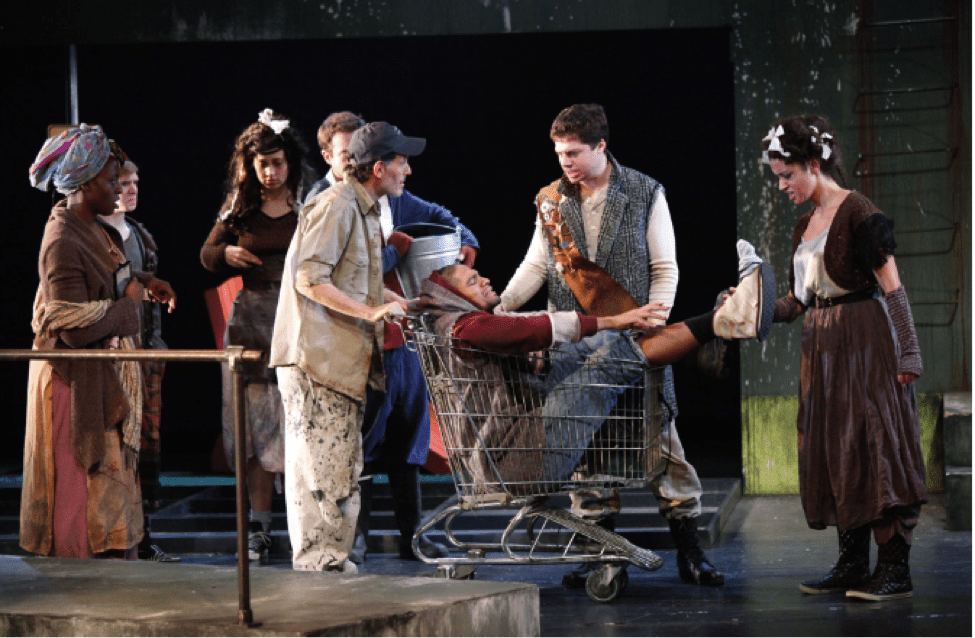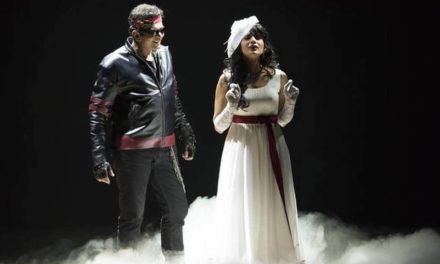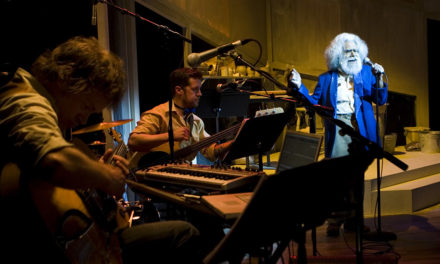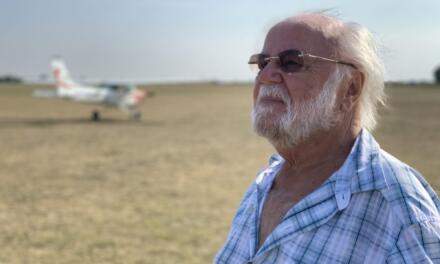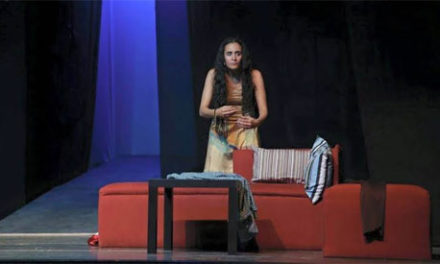The article below is one I wrote for the E-Newsletter Hamilton Dramaturgy’s ScriptForward! back in 2011, about my experience translating the contemporary Korean play Inching Towards Yeolha, by Sam-Shik Pai. My translation was adapted and produced at Columbia University as Walkabout Yeolha in 2010, directed by Kon Yi. While sharing my process of translation, I also raised questions about the state of translation of Korean plays, especially the scarcity of it in the U.S. Since then several new Korean and Korean-American voices have emerged, including Hansol Jung (Cardboard Piano at Humana Festival, Among the Dead at Ma-Yi Theater Company), Celine Song (The Feast at MAP Theater in Seattle), and Jihae Park (Peerless at Yale Repertory Theatre). Yet translation of contemporary Korean plays still remains an underexplored field. In the current climate where theatres actively pursue diversity and inclusivity, I believe translation can offer an additional international perspective. A production of a new translation opens up intercultural communication. For this reason revisiting and reposting my article on translation will hopefully bring new attention to the value of translated works.
In October 2010, Columbia University saw the staging of Walkabout Yeolha, an adaptation of a Korean play by Sam-Shik Pai. This production, an M.F.A. thesis project for Korean director Kon Yi („11), marked an encounter that, in my opinion, has yet to become more frequent: an exposure to contemporary Korean playwriting for a New York audience. It was with great pleasure and prestige that I became part of this project as translator of the original play by Pai.
It was in the summer of 2010 that the director Yi contacted me about this play, which, in Korea, premiered at Towol Theater in Seoul Arts Center, directed by Jin-Taek Sohn, in March 2007. A literal translation of the original title would be “Inching Towards Yeolha,” Yeolha being the destination of Jiwon Park (a.k.a. Yeon-Ahm), an 18th-century Korean philosopher who traveled to China in pursuit of practical ideas to modernize Korean society. Based on Yeon- Ahm‟s travelogue, The Jehol Diary, Pai created an allegorical satire, exploring the questions of tradition and innovation. Pai introduces us to a nearly-fossilized, fictive village in a desert, and guides us through the turbulence the village undergoes at its first encounter with what the villagers call the “exotic.” Yeon-Ahm, the narrator of the play, is a “four-legged beast” and, as she tells the villagers of the world outside the village, provides the initial conflict of the play. Her talking eventually makes her the scapegoat to save the village from being “erased.”
In the American theatre scene, contemporary Korean playwrights are only to be found by avid researchers aiming to find them. Part of the reason is that Korea‟s theatre development suffered a disconnect in the early twentieth century while it was under the dominance of Japan. Only after 1950 could Korean theatre emerge again. In the director‟s note, Yi mentions he found only three Korean playwrights whose works had been translated into English – Taesuk Oh, Yun-taek Lee and Kang-baek Lee – which gave him a strong incentive to bring Yeolha to life in New York. Though the three aforementioned playwrights are some of the most recognized playwrights in Korea, hardly any of their work has received a professional production in America. In theatre history education, the significance of Korean theatre is mostly allotted to the ritual tradition of Kut and mask dance called Talchum. However, these modern and contemporary playwrights are hardly covered compared to well-recognized Asian playwrights such as Gao Xingjian (China, The Bus Stop, The Other Shore), or Yukio Mishima (Japan, The Lady Aoi). While Korean-related themes are depicted by playwrights such as Young-Jean Lee (Song of The Dragons Flying to Heaven) and Lloyd Suh (American Hwangap), it is reasonable to say that these two authors write from a distinctive Korean-American perspective.
The American audience was first exposed to a Korean theatre production with the LaMaMa production of Prince Hamul, an adaptation of Hamlet, directed by Minsoo Ahn, in 1977. A revival of this piece called Hamyul/Hamlet played LaMaMa in July 2011, directed by Byungkoo Ahn, the son of Minsoo Ahn. Recently, more Korean troupes have been bringing their acclaimed productions to America. In 2009, Sadari Movement Laboratory performed their adaptation of Georg Büchner’s Woyzeck, directed by Do-Wan Lim, at the Public Theater as part of the Under the Radar Festival. Seoul Factory for the Performing Arts (SFPA) put on their adaptation of Euripides’ Medea, called Medea and Its Double, at LaMaMa in January 2010. These companies imaginatively fused western classics with traditional Korean performance elements and created original works crossing over both cultural traditions.
For our Walkabout production, the guarantee of performance, combined with the significance of representing a new Korean play to the New York audience, was certainly a big advantage as I entered into the translation. Picturing the performance venue, I imagined how the words of Pai could be delivered to the audience. My primary objective was to enable fluent communication between the two cultures: making what is Korean in Pai’s text present and relevant for the American audience. As is frequently touched upon, translation entails “cultural interpretation” and, therefore, requires not only proficiency in both languages but also a complete embracing of both cultures.
In Yeolha, my first challenge was to make explicit and active what is innately Korean. The village in the play takes after a traditional Korean village that operates on a hierarchy based on patriarchy and gerontocracy. What is unique in terms of language among people who have become so familiar with each other is that they often use insinuating and provocative remarks in place of straightforward statements. For example, to a prodigal son who returned home after a long absence, a Korean mother would reservedly say, “You‟re back already? Are you sure you had enough fun out there?” instead of bursting into tears and showing her joy at the reunion. In the play, the villagers by now have absorbed this kind of language pattern, which reflects the intimacy among them. The language among the villagers also reflects the hierarchy. For example, a village senior could throw a denigrating comment to a village woman or boy without being considered the least bit insulting. Showing respect for elders is, after all, deep in the Korean cultural genes, and elders, if not receiving the proper respect, actively demand it. While the play clearly provides the appropriate context for the tone of each word, it was my venture, when it came to the underlying Korean sentiments, to find the right expressions to convey the subtle nuance.
More broadly, delivering the right tone was of utmost importance for the allegory and satire in this play. The idea which prevails in the story – tradition being threatened by innovation – establishes this play as an allegory about the danger of complacency, while the chaos the villagers go through in the struggle brings out comic and satiric elements. Conflict occurs more often between groups or between individual and group than between individuals, so each character needed not only to breathe as an individual, but also to be characterized as a type, that is, as a member of a certain group. For example, the men, in general, give straightforward addresses, while the women speak more in a scrupulous manner. The seniors, to show their authority, use formal and commanding vocabulary, while the boys talk in fragments and colloquial idioms. The main characters are given their own particular ways of speaking: Yeon- Ahm, the narrator, speaks articulately and objectively, just like the Stage Manager in OUR TOWN; and the Inspector, to emphasize that he belongs to a completely different world, uses bombastic phrases and terms.
After completing the premiere of the adaptation of Inching Towards Yeolha, I am still seeking to make the original translation more compact and active for the stage. It is my hope that this play can generate more curiosity about Korean theatre and initiate more opportunities for contemporary Korean plays to be introduced.
This article was originally published in Hamilton Dramaturgy’s ScriptForward! (September, 2011, Vol. 6, No. 25). Reposted with permission
This post was written by the author in their personal capacity.The opinions expressed in this article are the author’s own and do not reflect the view of The Theatre Times, their staff or collaborators.
This post was written by Walter Byongsok Chon.
The views expressed here belong to the author and do not necessarily reflect our views and opinions.

